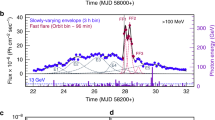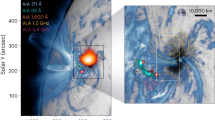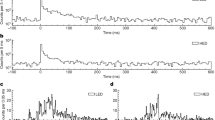Abstract
MR. BRUCE believes that the short-lived broadening which we observe in the Balmer emission lines during the “flash’ phase of an intense flare arises from a temporary magnetic field of the order of 105 gauss. If this is so, some explanation is needed of the fact that no comparable Zeeman broadening has been recorded in the emission lines of iron, calcium and silicon as photographed by C. W. Allen1 and myself2. Most of these lines show (in absorption) the normal Zeeman effect in sunspot spectra, where the fields are of the order of only 103 gauss.
This is a preview of subscription content, access via your institution
Access options
Subscribe to this journal
Receive 51 print issues and online access
$199.00 per year
only $3.90 per issue
Buy this article
- Purchase on Springer Link
- Instant access to full article PDF
Prices may be subject to local taxes which are calculated during checkout
Similar content being viewed by others
References
Allen, C. W., Mon. Not. Roy. Ast. Soc., 100, 635 (1940).
Ellison, M. A., Mon. Not. Roy. Ast. Soc., 106, 500 (1946).
Author information
Authors and Affiliations
Rights and permissions
About this article
Cite this article
ELLISON, M. Solar Flares and the Zeeman Effect. Nature 164, 280–281 (1949). https://doi.org/10.1038/164280b0
Issue Date:
DOI: https://doi.org/10.1038/164280b0
This article is cited by
-
Solar flares and the origin of cosmic radiation
Il Nuovo Cimento (1949)
Comments
By submitting a comment you agree to abide by our Terms and Community Guidelines. If you find something abusive or that does not comply with our terms or guidelines please flag it as inappropriate.



